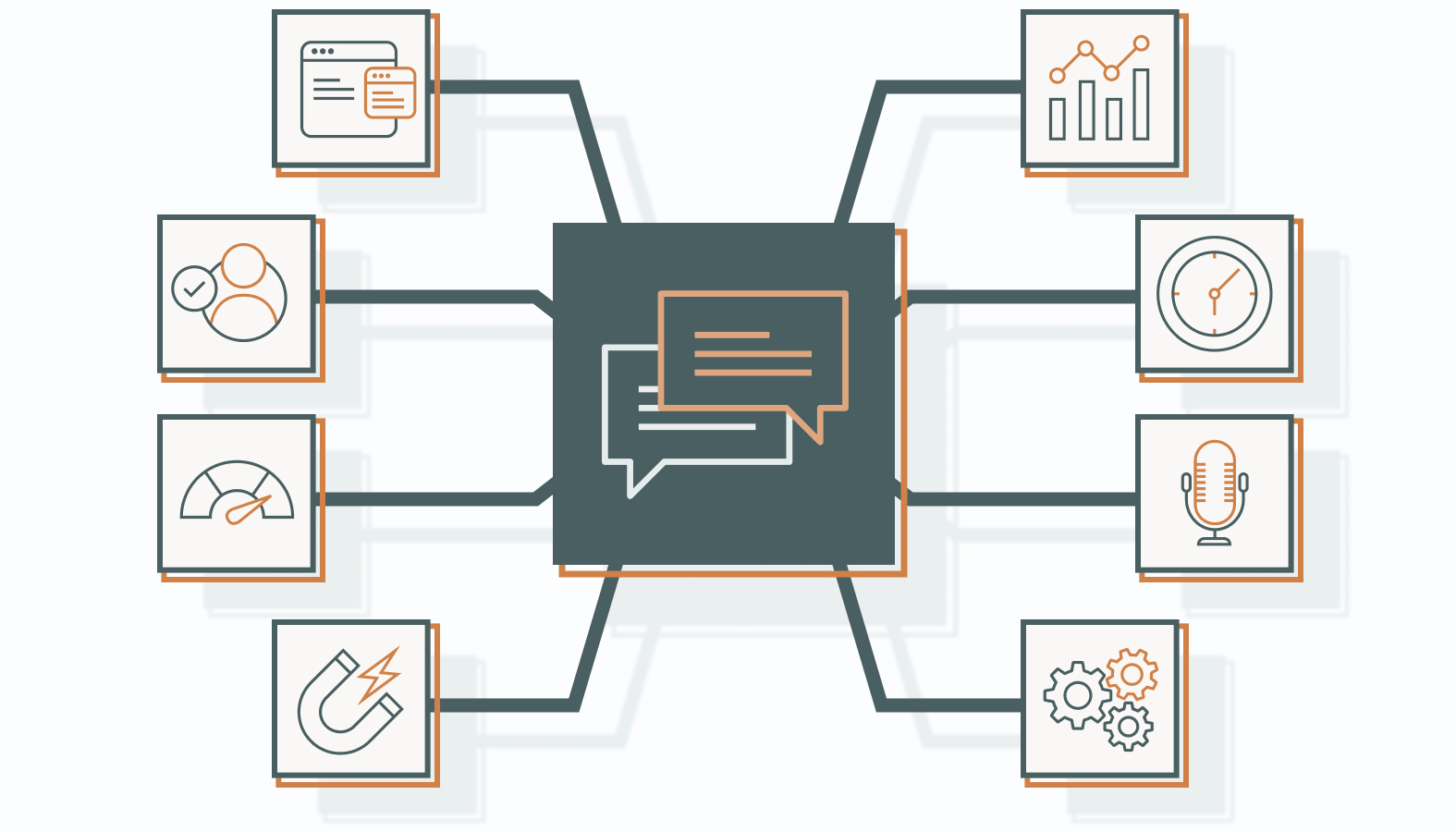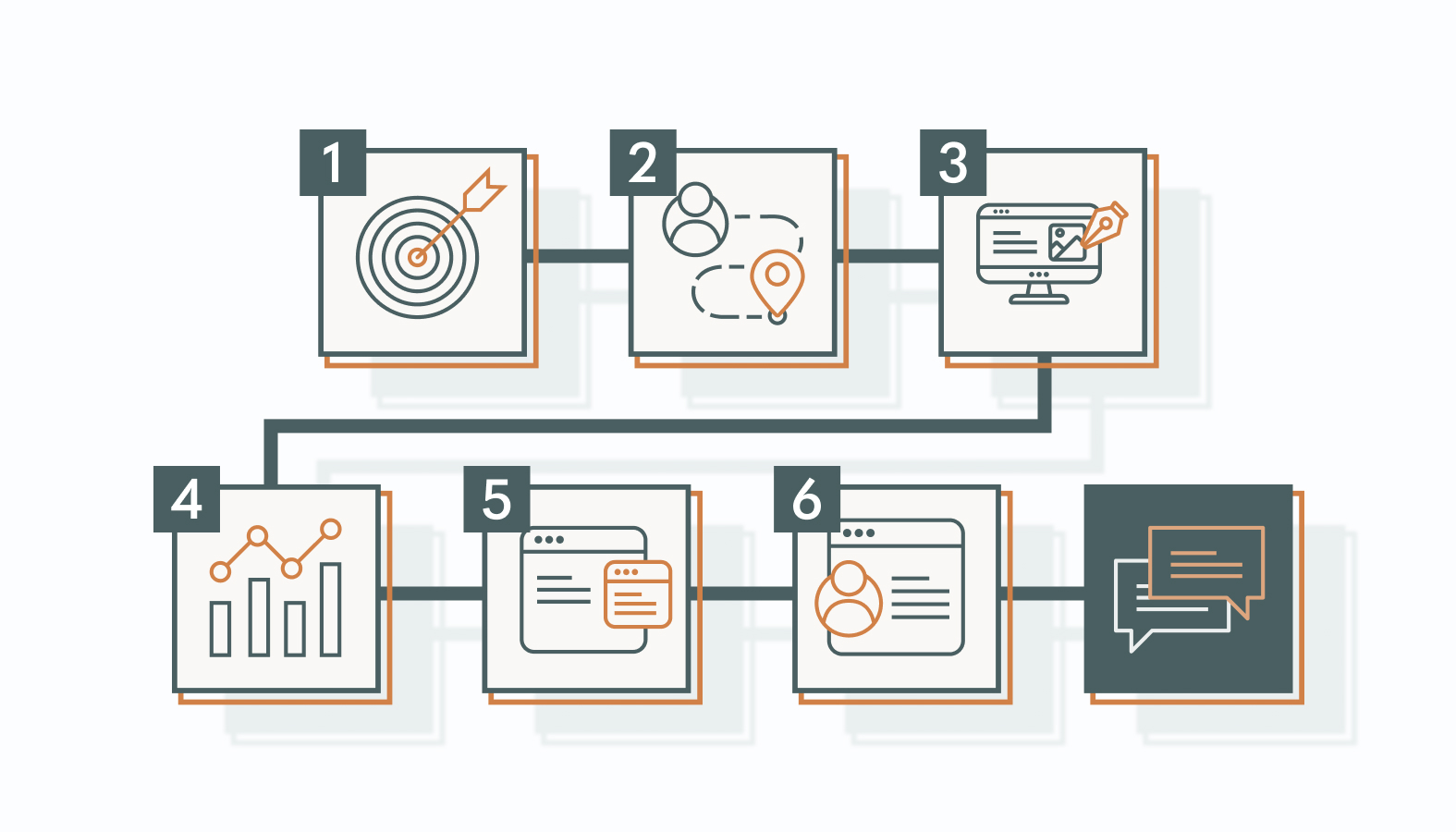If your marketing channels feel stretched too thin or engagement isn’t where you want it, a chatbot marketing strategy can help. Chatbots answer questions, guide users through your site, and even deliver personalized recommendations, all without adding extra staff.
But making a bot that truly adds value takes more than automation. It requires thoughtful design, smart placement, and ongoing refinement.
In this article, we’ll explore how to plan and implement a chatbot marketing strategy that actually helps your business connect with customers and get measurable results.
The Power of Chatbot Marketing
In a world where customers expect instant answers, speed, and intelligence are no longer optional. They’re survival skills. Chatbots can be your 24/7 marketing co-pilot, anticipating needs, delivering information, and keeping your brand in the fast lane.
Whether on your website, social channels, or messaging apps, chatbots handle the grunt work with precision while letting your team focus on strategy, creativity, and the big wins. They’re the ultimate combination of brains and endurance: always alert, never tired, and annoyingly effective.
What is Chatbot Marketing?
At its core, chatbot marketing is about more than automation. It’s about strategic, real-time conversation, guiding users, capturing insights, and creating experiences that feel personalized, effortless, and just smart.
These bots integrate seamlessly with your broader marketing strategy, reinforcing campaigns, driving leads, and enhancing customer engagement without asking for a single coffee break.
Chatbots are not a gimmick. They’re a performance accelerator, a data collector, and a brand ambassador rolled into one digital powerhouse.
Benefits of Chatbot Marketing
Here’s why every marketing team should leverage the power of chatbots:
- Instant Engagement: No waiting, no tickets, no “we’ll get back to you.” Users get answers now, which means they stay, explore, and convert.
- Scale Personalization: Analyze behavior, past interactions, and preferences, then deliver tailored recommendations across thousands of conversations without dropping the human touch.
- Efficiency Upgrade: Routine inquiries, bookings, and lead qualification handled automatically. Your team gets to focus on strategy, creativity, and growth – tasks bots can’t steal your thunder from.
- Lead Generation Ninja: Capture high-value prospects, segment intelligently, and schedule follow-ups in real time. It’s like having a sales assistant who never sleeps or complains.
- Data-Driven Insights: Every interaction tells a story – drop-offs, sentiment, trending queries. Use it to refine content, messaging, and your next campaign like a pro.
- 24/7 Availability: Bots never clock out. Customers get answers anytime, building trust and keeping prospects engaged instead of frustrated.
- Consistency and Brand Voice: Every conversation mirrors your tone, style, and personality. Bots don’t wander off-brand – they amplify it.
- Resource Optimization: Automate routine tasks, reduce manual labor, and free your team to tackle high-value work. More time, more focus, more impact.
Bottom line: A well-deployed chatbot saves your team valuable time. It also amplifies your marketing IQ, strengthens relationships, and drives results that matter. Think of it as a brilliant, tireless teammate who’s always on call, never complains, and actually improves your bottom line.
How to Create a Successful Chatbot Marketing Strategy
Launching a chatbot involves creating a system that actually delivers value.
A successful chatbot marketing strategy aligns technology with your business goals, guides customers naturally, and turns every interaction into an opportunity to strengthen relationships.
Here’s how you can transform bots from a novelty into a dependable part of your marketing engine:
1) Define Your Objectives Clearly
Start with measurable goals to guide the strategy and measure success.
- Identify what success looks like: faster support, higher lead conversion, or improved engagement.
- Align chatbot goals with overall business objectives to ensure consistency.
- Prioritize resources based on which goals will have the biggest impact.
Determine key performance indicators (KPIs) early so you can track results and pivot quickly if needed.
2) Map Customer Journeys and Touchpoints
Design interactions that guide users through your funnel with clarity.
- Analyze typical paths users take and pinpoint where they may drop off.
- Incorporate behavioral data and customer feedback to refine touchpoints.
- Create intuitive entry points and decision flows that feel natural.
Consider different user segments – new visitors, returning customers, or high-value leads – to tailor interactions for each group.
3) Optimize Chatbot Placement
Deploy bots where they can make the most difference.
- Evaluate high-traffic areas: homepage, product pages, social channels, or messaging apps.
- Consider user intent and context for each placement – where are users most likely to need help or guidance?
- Test different placements and messaging to see what drives engagement and conversions.
Ensure your bot is unobtrusive but easily accessible, striking the right balance between visibility and user experience.
4) Leverage Data and Analytics
Use metrics to refine performance and stay ahead of user needs.
- Track interactions, response times, drop-offs, and common questions.
- Measure satisfaction scores and conversion rates to understand impact.
- Identify patterns in customer behavior that reveal opportunities to improve scripts or handoffs.
Use insights to adjust prompts, workflows, and touchpoints continuously. Chatbots improve most when they evolve with real-world data.
5) Create Smooth and Natural Conversations
Make interactions feel human, engaging, and aligned with your brand voice.
- Use approachable language that reflects your brand personality.
- Anticipate user intent to guide interactions intelligently.
- Include error-handling and fallback options to prevent frustration.
Personalize responses where possible, using data to make interactions feel relevant and thoughtful.
6) Train Chatbots for Seamless Human Handoffs
Even the smartest bots hit a limit. Make transitions to human agents frictionless.
- Define clear criteria for when escalation is needed.
- Pass relevant context to the human agent so users don’t repeat themselves.
- Maintain a friendly, confident tone during handoffs to keep trust intact.
- Consider proactive alerts to your team for high-value or urgent interactions.
When each of these elements comes together, your chatbot marketing strategy becomes a high-performing tool that strengthens engagement, drives measurable results, and complements your broader marketing efforts.
Chatbot Marketing Techniques for Diverse Applications
Chatbots are tactical tools you can deploy across multiple channels to engage customers, streamline processes, and capture opportunities in real time.
The trick isn’t just setting them up; it’s knowing how to use them effectively. From generating leads to personalizing experiences and keeping social conversations lively, these techniques turn chatbots from flashy novelties into powerhouse members of your marketing team.
Generate and Qualify Leads Like a Pro
Chatbots can instantly engage visitors, ask the right questions, and determine who’s a serious prospect.
- Use conversational scripts to capture essential details like email, needs, and interest level.
- Segment leads automatically so your sales team focuses only on the high-potential prospects.
- Identify behaviors that indicate purchase intent – like repeat visits or engagement with key content – and prioritize those leads.
- Follow up with context-aware messaging, keeping prospects engaged without spamming.
Deliver Hyper-Personalized Product Recommendations
Turn customer data into meaningful suggestions that feel human.
- Analyze browsing patterns, purchase history, and expressed preferences to suggest relevant products or services.
- Trigger recommendations at critical moments in the customer journey, like when they hesitate on a product page.
- Cross-sell or upsell without being pushy, making the conversation feel intuitive rather than robotic.
- Use behavioral insights to refine suggestions and keep recommendations fresh and relevant continuously.
Streamline Social Media Engagement
Chatbots can manage the front lines of social channels without sacrificing your brand voice.
- Automate replies to common questions while maintaining a friendly, on-brand tone.
- Handle high-volume interactions during peak hours, ensuring no inquiry goes unanswered.
- Monitor sentiment in real-time and escalate tricky conversations to human agents promptly.
- Keep engagement conversational and adaptable, avoiding cookie-cutter responses that feel robotic.
Drive Event Registrations and Webinar Participation
Turn events into high-impact experiences with chatbot-powered guidance.
- Automate registration and confirmation processes for webinars, workshops, or live events.
- Send timely reminders, updates, and relevant resources to attendees.
- Address attendee questions instantly, from agenda details to technical access instructions.
- Use chatbots to collect feedback post-event, helping improve future events and strengthen relationships.
Supercharge SEO with Smart Chatbot Integration
Chatbots can also play a pivotal role in boosting your search engine performance. When integrated thoughtfully, they enhance site usability, keep visitors navigating longer, and give search engines exactly what they love: happy, engaged users.
But this isn’t just about sprinkling a bot on your homepage. It means strategically leveraging conversational AI to improve visibility, gather insights, and continuously optimize your website for both users and search engines.
Enhance User Experience and Site Navigation
A chatbot isn’t just an FAQ machine. It’s your guide, concierge, and problem-solver rolled into one. The smoother users find their journey on your site, the more likely they are to stay, explore, and convert.
- Quick Answers: Instantly address common questions, reducing friction and keeping visitors from bouncing.
- Intelligent Routing: Direct users to the exact pages or resources they need, improving navigation flow.
- Contextual Recommendations: Suggest relevant content, products, or services based on user behavior, keeping visitors engaged and moving deeper into your site.
- Accessibility Boost: Make your site more usable for all visitors, including those unfamiliar with your layout or offerings, which indirectly improves engagement metrics valued by search engines.
Collect and Apply Actionable SEO Data
Chatbots are data goldmines. Every interaction tells a story about what your audience is looking for, struggling with, or curious about. When used strategically, this data directly informs your SEO strategy.
- Query Tracking: Monitor what users ask most often to identify content gaps and high-value keywords.
- Behavior Patterns: Analyze which links, pages, or prompts drive engagement – and adjust navigation or content accordingly.
- Content Optimization: Use chatbot insights to improve meta descriptions, headings, and internal linking based on real user intent.
- User Feedback: Gather qualitative data on satisfaction or confusion points, helping refine content and site structure to match visitor expectations.
Drive Conversions While Supporting SEO Goals
A chatbot can simultaneously improve user experience and contribute to measurable business outcomes. Search engines reward sites that deliver value efficiently, and chatbots help you do just that.
- Reduce Bounce Rate: Guide users quickly to the content they need, keeping them on your site longer.
- Increase Engagement Depth: Encourage exploration through dynamic recommendations and guided navigation paths.
- Improve Page Authority: By linking users to relevant internal pages, chatbots help search engines understand your site structure, boosting SEO.
- Support Multi-Channel SEO: Extend conversational touchpoints to social media or messaging apps, creating cohesive signals across channels that strengthen your search presence.
By improving usability, capturing actionable data, and guiding users efficiently through your site, chatbots transform your web presence from “just another page” into a dynamic, search-optimized experience.
Master Chatbot Marketing with Proven Best Practices
A high-performing chatbot isn’t a set-it-and-forget-it tool. You should consider it as a living, evolving part of your marketing engine.
To extract real value, businesses need to adopt a disciplined approach rooted in continuous optimization, strategic engagement, and proactive learning.
These best practices ensure your chatbots remain not just functional, but influential.
1) Continuously Optimize Through Testing and Insights
Smart bots improve over time. Without a structured feedback loop, even the most sophisticated chatbot can fall flat.
- A/B Test Interaction Flows: Experiment with different prompts, conversation paths, or calls-to-action to discover which approach drives better engagement and conversions.
- Analyze Interaction Metrics: Track completion rates, user drop-offs, and response satisfaction to pinpoint friction points.
- Iterative Content Updates: Refresh scripts and suggestions based on patterns in user behavior – keep the conversation sharp, helpful, and relevant.
- Monitor Behavioral Signals: Detect hesitation, repeated questions, or abandoned actions as opportunities to refine messaging and nudge users effectively.
2) Implement Proactive Engagement Strategies
Waiting for users to initiate interaction isn’t enough. The right bot knows when to step in – without being intrusive.
- Behavior-Based Triggers: Initiate conversations based on dwell time, page scroll, or repeated visits to keep users moving through your funnel.
- Contextual Prompts: Offer tailored guidance or recommendations aligned with the page or product a user is exploring.
- Personalized Nudges: Leverage previously collected data to make engagement feel relevant and timely, increasing the chance of meaningful action.
- Event-Driven Interventions: Trigger interactions during seasonal campaigns, promotions, or live events to maximize engagement and conversions.
3) Maintain Brand Consistency and Conversational Quality
Every interaction is a reflection of your brand. A bot that misrepresents your voice can do more harm than good.
- Consistent Tone and Language: Ensure scripts reflect your brand personality: professional, playful, authoritative, or witty, without sounding robotic.
- Error Handling and Recovery: Anticipate confusion, provide fallback suggestions, and gracefully redirect users to human support when needed.
- Personalization Layers: Reference previous interactions, preferences, or account details to make each conversation feel tailored rather than generic.
4) Monitor, Learn, and Adapt
A chatbot is only as smart as the insights it delivers. Treat it as a data-generating asset to continuously improve both your bot and broader marketing efforts.
- Feedback Loops: Encourage users to rate interactions or leave comments to understand pain points.
- Cross-Functional Insights: Share learnings with sales, support, and content teams to align messaging and optimize conversion pathways.
- Scalable Improvements: Use insights from high-performing conversations to train the bot, increasing efficiency across thousands of interactions.
5) Balance Automation with Human Touch
Even the most capable AI can’t replace nuance or empathy. Seamless escalation ensures complex issues are resolved without frustrating your audience.
- Clear Handoff Protocols: Define when and how conversations transition to a human agent.
- Context Preservation: Pass conversation history to the agent so users don’t repeat themselves.
- Strategic Alerts: Flag high-value or urgent interactions to your team proactively, ensuring timely follow-up.
By following these best practices, chatbots evolve from novelty tools into strategic allies – driving engagement, generating insights, and boosting conversions while maintaining the sophistication and charm of a highly skilled team member.
With the right approach, your bot isn’t just answering questions; it’s expanding your marketing capabilities in ways that feel effortless and intelligent.
Your Chatbot, Upgraded: Turning Strategy Into Impact
Integrating chatbots goes beyond just slapping AI onto your site. It’s about turning conversation into strategy, data into decisions, and engagement into measurable results. The bots you deploy should do more than respond: they should guide, anticipate, and elevate every interaction.
Success comes down to a few core principles: set sharp objectives, map customer journeys with precision, and place your chatbots where they’ll have the most impact. Layer in continuous optimization, proactive engagement triggers, and data-driven tweaks, and you’re not just keeping up – you’re staying ahead.
Your chatbot can be a relentless team member: always on, always learning, and always pushing engagement to the next level. Done right, it sharpens your marketing IQ, streamlines operations, and strengthens customer relationships, all while making your brand look faster, smarter, and effortlessly in control.
Ready to stop guessing and start dominating with chatbots? Schedule a candid conversation with one of our experts to explore how chatbot marketing can transform your business – or build a full strategy from start to finish.










